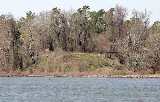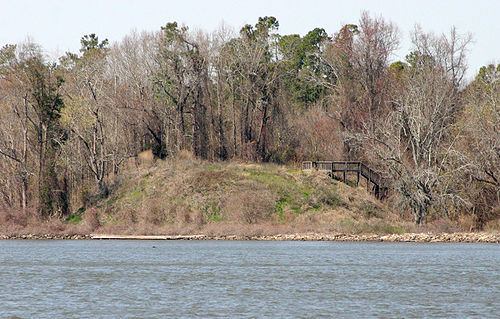
Santee tribe
Encyclopedia
The Santee Indian Organization, a remnant tribe, was officially recognized by the South Carolina
Commission for Minority Affairs, January 27, 2006. Historically it was a small tribe (est. 3000 around 1600 AD), speaking a Siouan language and centered in the area of the present town of Santee, South Carolina
. Their settlement was along the Santee River
, since dammed and called Lake Marion
.
states, where they had migrated and settled before European contact.
Some Siouan-speaking tribes also inhabited territory in present-day Virginia
, Maryland
and North Carolina
. It is possible that some Upper South areas are named for the Santee, like the Big Sandy or Sandy Rivers of Carolina and East Kentucky. English translation of Indian words was often lacking, and errors were and are common, even today. The Santee have Lower Town connections to the Cherokee and groups later called Creek, due to westward movement of Indians during the Colonial Conguest era.
 An earthwork
An earthwork
mound
believed to have been constructed by the Mississippian culture
(1000-1500 AD) stands on the shore of Lake Marion. This structure was likely built by prehistoric indigenous peoples
of the area, before the coalescence of the Santee as a tribe. The mound was probably the burial of a chief of shaman. Historically the latter spoke Catawba
.
South Carolina
South Carolina is a state in the Deep South of the United States that borders Georgia to the south, North Carolina to the north, and the Atlantic Ocean to the east. Originally part of the Province of Carolina, the Province of South Carolina was one of the 13 colonies that declared independence...
Commission for Minority Affairs, January 27, 2006. Historically it was a small tribe (est. 3000 around 1600 AD), speaking a Siouan language and centered in the area of the present town of Santee, South Carolina
Santee, South Carolina
Santee is a town in Orangeburg County along the Santee River Valley in central South Carolina of the United States. It has become a resort town of note located centrally north-south along the Atlantic Seaboard of South Carolina...
. Their settlement was along the Santee River
Santee River
The Santee River is a river in South Carolina in the United States, long. The Santee and its tributaries provide the principal drainage and navigation for the central coastal plain of South Carolina, emptying into the Atlantic Ocean approximately from its farthest headwater on the Catawba River...
, since dammed and called Lake Marion
Lake Marion (South Carolina)
Lake Marion is the largest lake in South Carolina, centrally located and with territory within five counties. The lake is referred to as South Carolina's inland sea. It has a shoreline and covers nearly 110,000 acres of rolling farmlands, former marshes, and river valley landscape...
.
History
Historically, the great majority of various Siouan-speaking tribes were found in the Great PlainsGreat Plains
The Great Plains are a broad expanse of flat land, much of it covered in prairie, steppe and grassland, which lies west of the Mississippi River and east of the Rocky Mountains in the United States and Canada. This area covers parts of the U.S...
states, where they had migrated and settled before European contact.
Some Siouan-speaking tribes also inhabited territory in present-day Virginia
Virginia
The Commonwealth of Virginia , is a U.S. state on the Atlantic Coast of the Southern United States. Virginia is nicknamed the "Old Dominion" and sometimes the "Mother of Presidents" after the eight U.S. presidents born there...
, Maryland
Maryland
Maryland is a U.S. state located in the Mid Atlantic region of the United States, bordering Virginia, West Virginia, and the District of Columbia to its south and west; Pennsylvania to its north; and Delaware to its east...
and North Carolina
North Carolina
North Carolina is a state located in the southeastern United States. The state borders South Carolina and Georgia to the south, Tennessee to the west and Virginia to the north. North Carolina contains 100 counties. Its capital is Raleigh, and its largest city is Charlotte...
. It is possible that some Upper South areas are named for the Santee, like the Big Sandy or Sandy Rivers of Carolina and East Kentucky. English translation of Indian words was often lacking, and errors were and are common, even today. The Santee have Lower Town connections to the Cherokee and groups later called Creek, due to westward movement of Indians during the Colonial Conguest era.

Earthworks (archaeology)
In archaeology, earthwork is a general term to describe artificial changes in land level. Earthworks are often known colloquially as 'lumps and bumps'. Earthworks can themselves be archaeological features or they can show features beneath the surface...
mound
Mound
A mound is a general term for an artificial heaped pile of earth, gravel, sand, rocks, or debris. The most common use is in reference to natural earthen formation such as hills and mountains, particularly if they appear artificial. The term may also be applied to any rounded area of topographically...
believed to have been constructed by the Mississippian culture
Mississippian culture
The Mississippian culture was a mound-building Native American culture that flourished in what is now the Midwestern, Eastern, and Southeastern United States from approximately 800 CE to 1500 CE, varying regionally....
(1000-1500 AD) stands on the shore of Lake Marion. This structure was likely built by prehistoric indigenous peoples
Indigenous peoples
Indigenous peoples are ethnic groups that are defined as indigenous according to one of the various definitions of the term, there is no universally accepted definition but most of which carry connotations of being the "original inhabitants" of a territory....
of the area, before the coalescence of the Santee as a tribe. The mound was probably the burial of a chief of shaman. Historically the latter spoke Catawba
Catawba language
Catawba is one of two Eastern Siouan languages of the eastern US, which together with the Western Siouan languages formed the Siouan language family....
.

